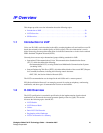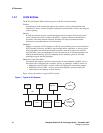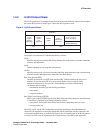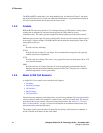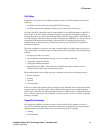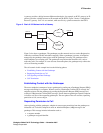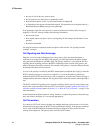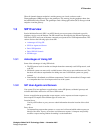32 Dialogic
®
Global Call IP Technology Guide — November 2007
Dialogic Corporation
IP Overview
The RTP and RTCP combination is for media handling only. As indicated in Figure 2, the media
part of the H.323 protocol is carried over UDP and therefore there is no guarantee that all packets
will arrive at the destination and be placed in the correct order.
1.2.3 Codecs
RTP and RTCP data is the payload of a User Datagram Protocol (UDP) packet. Analog signals
coming from an endpoint are converted into the payload of UDP packets by codecs
(coders/decoders). The codecs perform compression and decompression on the media streams.
Different types of codecs provide varying sound quality. The bit rate of most narrow-band codecs is
in the range 1.2 kbps to 64 kbps. The higher the bit rate the better the sound quality. Some of the
most popular codecs are:
G.711
Provides a bit rate of 64 kbps.
G.723.1
Provides bit rates of either 5.3 or 6.4 kbps. Voice communication using this codec typically
exhibits some form of degradation.
G.729
Provides a bit rate of 8 kbps. This codec is very popular for voice over frame relay and for V.70
voice and data modems.
GSM
Provides a bit rate of 13 kbps. This codec is based on a telephony standard defined by the
European Telecommunications Standards Institute (ETSI). The 13 kbps bit rate is achieved
with little degradation of voice-grade audio.
1.2.4 Basic H.323 Call Scenario
A simple H.323 call scenario can be described in five phases:
• Call Setup
• Capability Exchange
• Call Initiation
• Data Exchange
• Call Termination
Calls between two endpoints can be either direct or routed via a gatekeeper. This scenario describes
a direct connection where each endpoint is a point of entry and exit of a media flow. The scenario
described in this section assumes a slow start connection procedure. See Section 4.2, “Fast and
Slow Call Setup Modes”, on page 115 for more information on the difference between the slow
start and fast start connection procedure.
The example in this section describes the procedure for placing a call between two endpoints, A
and B, each with an IP address on the same subnet.








